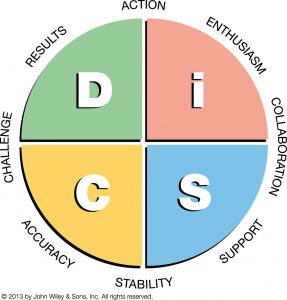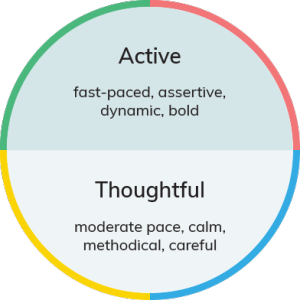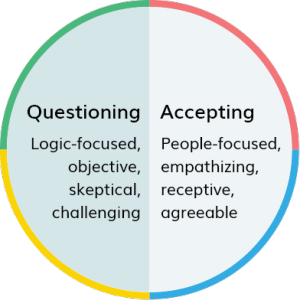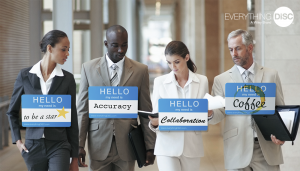 A Powerful Way to Understand People Using the Everything DiSC Concept
A Powerful Way to Understand People Using the Everything DiSC Concept
Each Person has Unique Personality Traits
Each person’s perspective is built into who they are.
Some people call it “personality” and some refer to it as “temperament.”
Ever notice how different that your family and friends can be from you? If you are like me, you have asked yourself, “Why did they do that?” or “What were they thinking?”
The starting point of understanding people is to realise and accept one simple fact:
NOBODY THINKS LIKE YOU
Have you ever said the same thing to two people and received two different reactions? How can saying the same words produce such different results? Each person “heard” you differently based on his or her personality style! You said the same thing, but what they “heard” was different.
Different is not necessarily bad; it is just different! A lack of understanding of ourselves and others can lead to real problems such as tension, disappointment, hurt feelings, unmet expectations and poor communication. As you know, it is hard to work with a challenge, especially if you do not understand what is going on inside the mind of another person.
There IS a Simple Way to Understand People!
The good news is that there is a simple key to understand how people behave and how they are motivated. We call the concept “The Everything DiSC model.” This concept will allow you to unlock the mystery behind developing excellent people skills and creating better relationships. You will be able to use what you learn in this introduction to reduce conflict, improve productivity and relate with others more effectively and ensure that when you start a new project, you do it accurately using the correct people.
Some Background on the DISC Model of Human Behavior
Twenty-four hundred years ago, scientists and philosophers, most notably Hippocrates, began to recognise and categorise differences in behaviour that seemed to follow a pattern.
Since then, many psychologists and scientists have explored behavioural patterns. Dr William Marston wrote “The Emotions of Normal People” in 1928 after earning his doctorate from Harvard University. Marston theorised that people are motivated by four intrinsic drives that direct behavioural patterns. He used four descriptive characteristics for behavioural tendencies which are represented by four letters of the alphabet: D, I, S and C. Thus the concept of “DISC” was introduced.
I have reviewed many different models and have found Wiley’s “everything DiSC” to be the best due to their latest developments around creating individual profiles by using adaptive testing.
I first discovered “DISC” over 20 years ago from a good friend who helped me to understand how I could better interact with a member of the team who was just unbearable. The concept was so revolutionary that I have used it every day since then. I have trained thousands of people to use the skills that have changed my life.
Building on a “Wellness” Model
Many behavioural models focus on what is wrong with a person to identify “personality disorders.” The DISC model is based on standard behaviour, not abnormal behaviour.
DISC is a “wellness model” that is objective and descriptive rather than subjective and judgmental.
Therefore, DISC is a practical way to understand yourself and those around in the familiar settings of everyday life.
A Positive Approach
 The DISC wellness model is an essential framework for understanding people. DISC is used positively to encourage a person to be his or her best – not as a way to “label” someone.
The DISC wellness model is an essential framework for understanding people. DISC is used positively to encourage a person to be his or her best – not as a way to “label” someone.
Healthy, positive relationships come from having an accurate understanding of yourself and others. DISC is a powerful tool for obtaining a new appreciation of our personality styles and their effect on our everyday lives.
We apply the DISC model with four main ideas that allow it to be used appropriately as a useful and encouraging tool
I have a saying that, “your strengths should carry you while your blind-spots should concern you.” Being able to identify and articulate your strengths can be very empowering. Being able to identify and uncover blind-spots can also be very empowering! The next few pages can be the start of your empowering discovery process.
So, now that you know where the DISC concept came from and the importance of having a positive, flexible approach, let’s take a look at the Model of Human Behavior using the DISC!
How could awareness of DiSC Help??
The course aims to help the delegates understand themselves and also to see how others could see them. We can then learn to adapt to be seen in a better light, work better together and achieve better results.
The DISC Model of Human Behavior
The model of human behaviour is based on two foundational observations about how people normally behave:
Observation #1: Some people are more OUTGOING, while others are more RESERVED.
 You can think of this trait as each person’s “internal motor” or “pace.” Some people always seem ready to “go” and “dive in” quickly. They engage their motor immediately. Others tend to engage their motor more slowly or more cautiously.
You can think of this trait as each person’s “internal motor” or “pace.” Some people always seem ready to “go” and “dive in” quickly. They engage their motor immediately. Others tend to engage their motor more slowly or more cautiously.
Observation # 2: Some people are more TASK-ORIENTED, while others are more PEOPLE-ORIENTED.
You can think of this as each person’s “external focus” or “priority” that guides them. Some people are focused on getting things done (tasks); others are more tuned-in to the people around them and their feelings.
 With both observations, we want to emphasise that these behavioural tendencies are neither right or wrong or good or bad. They are just different. We are merely identifying common behaviour styles. People have different styles, and that is okay. We represent these two observations in the diagrams below.
With both observations, we want to emphasise that these behavioural tendencies are neither right or wrong or good or bad. They are just different. We are merely identifying common behaviour styles. People have different styles, and that is okay. We represent these two observations in the diagrams below.
Four Major Personality Traits
In review, we have four behavioural tendencies to help us characterise people:
· Outgoing
· Reserved
· Task-oriented
· People-oriented
Everyone has some or all 4 of these tendencies at different times and in different situations. However, most people typically have 1 or 2 of these tendencies that seem to fit them well in their everyday behaviour. And, on the other hand, 1 or 2 of these tendencies usually do not provide them well, and these tendencies may even seem “foreign” to their approach to life. The balance of these four tendencies shapes the way each person “sees” life and those around them. By combining the two previous diagrams, we can show four primary quadrants of the circle, as shown below:
Four Major Personality Traits / Tendencies
Thus, four essential personality traits emerge from our diagram corresponding to the four quadrants of the circle (In clockwise order):
· Outgoing and Task-oriented (upper left quadrant)
· Outgoing and People-oriented (upper right quadrant)
· Reserved and People-oriented (lower right quadrant)
· Reserved and Task-oriented (lower left quadrant)
Next, we will add descriptive terms for each of the four main personality types that emerge in the diagram. The descriptive terms will begin with D, I, S and C.
Describing Each Personality Style
(4 Different Types – 4 Different Priorities)
As mentioned before, we will add descriptive terms to the diagram. Notice the letters D, I, S and C appear in the four quadrants of the circle in the picture below. You will also notice that descriptive terms have been added in each of the four corners of the diagram.
D-I-S-C Descriptive Terms
 What Is Your PQ (Personality Quotient)?
What Is Your PQ (Personality Quotient)?
We spend years in school, developing our intelligence to use our mind effectively. Developing a unique personality to use our behaviour effectively is just as vital to successful living. Your Intelligence Quotient, or IQ, measures your intelligence. Your Personality Quotient, or PQ, refers to your ability to understand yourself and others for effective communication and teamwork. Studies have shown that technical skill, beginning with intelligence and developed through education and experience, accounts for only 15% of success in the workplace. The other 85% of workplace success comes from people skills! These skills are developed through learning better ways to behave and interact.
The Elevator Test: Which Type Are You?
The elevator doors are about to close on an eager rider who is trying to get on the elevator. Four people are already inside the elevator. One of the people in the crowded box is in a hurry and does not want to wait (outgoing and task-oriented). There is also a bubbly, energetic passenger who holds the door open while greeting the newcomer (outgoing and people-oriented). A third rider is happy either way and smiles while waiting patiently (reserved and people-oriented). The final passenger is concerned as she calculates the weight to see if the elevator can handle another person (reserved and task-oriented).
While not entirely scientific, this scenario illustrates the Dominant (outgoing/task- oriented) person who is focused on getting somewhere fast; the Inspiring (outgoing / people-oriented) person who is energized by all the interaction; the Supportive (reserved / people-oriented) person who reacts calmly and tries to get along regardless; and the Cautious (reserved / task-oriented) person who wants to make sure the added person doesn’t exceed the weight limit! As you can see, four different people responded to the same event in four very different ways!
Learning How to Work with Other People (the next step is…):
There are four necessary steps in learning how to work with other people:
1. Learn about the DISC Model of Human Behavior
2. Take a personality assessment (personality test) to determine your exact personality blend.
3. Decide if it is just for you or for the organisation you work for and we can then arrange to train you to use DiSC to improve your life.
4. Here are some example reports to look through (Mine)
• Workplace Profile (for all employees)
• Managers profile (for anyone who manages)
• Sales Profile (For salespeople)
• Work of leaders (coming soon)
Sincerely,
Craig Campbell





